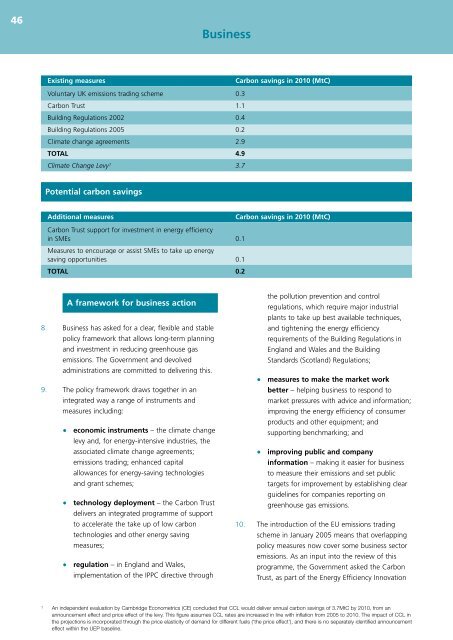UK Climate Change Programme 2006 - JNCC - Defra
UK Climate Change Programme 2006 - JNCC - Defra
UK Climate Change Programme 2006 - JNCC - Defra
Create successful ePaper yourself
Turn your PDF publications into a flip-book with our unique Google optimized e-Paper software.
46<br />
Business<br />
Existing measures<br />
Carbon savings in 2010 (MtC)<br />
Voluntary <strong>UK</strong> emissions trading scheme 0.3<br />
Carbon Trust 1.1<br />
Building Regulations 2002 0.4<br />
Building Regulations 2005 0.2<br />
<strong>Climate</strong> change agreements 2.9<br />
TOTAL 4.9<br />
<strong>Climate</strong> <strong>Change</strong> Levy 1 3.7<br />
Potential carbon savings<br />
Additional measures<br />
Carbon savings in 2010 (MtC)<br />
Carbon Trust support for investment in energy efficiency<br />
in SMEs 0.1<br />
Measures to encourage or assist SMEs to take up energy<br />
saving opportunities 0.1<br />
TOTAL 0.2<br />
A framework for business action<br />
8. Business has asked for a clear, flexible and stable<br />
policy framework that allows long-term planning<br />
and investment in reducing greenhouse gas<br />
emissions. The Government and devolved<br />
administrations are committed to delivering this.<br />
9. The policy framework draws together in an<br />
integrated way a range of instruments and<br />
measures including:<br />
• economic instruments – the climate change<br />
levy and, for energy-intensive industries, the<br />
associated climate change agreements;<br />
emissions trading; enhanced capital<br />
allowances for energy-saving technologies<br />
and grant schemes;<br />
• technology deployment – the Carbon Trust<br />
delivers an integrated programme of support<br />
to accelerate the take up of low carbon<br />
technologies and other energy saving<br />
measures;<br />
• regulation – in England and Wales,<br />
implementation of the IPPC directive through<br />
the pollution prevention and control<br />
regulations, which require major industrial<br />
plants to take up best available techniques,<br />
and tightening the energy efficiency<br />
requirements of the Building Regulations in<br />
England and Wales and the Building<br />
Standards (Scotland) Regulations;<br />
• measures to make the market work<br />
better – helping business to respond to<br />
market pressures with advice and information;<br />
improving the energy efficiency of consumer<br />
products and other equipment; and<br />
supporting benchmarking; and<br />
• improving public and company<br />
information – making it easier for business<br />
to measure their emissions and set public<br />
targets for improvement by establishing clear<br />
guidelines for companies reporting on<br />
greenhouse gas emissions.<br />
10. The introduction of the EU emissions trading<br />
scheme in January 2005 means that overlapping<br />
policy measures now cover some business sector<br />
emissions. As an input into the review of this<br />
programme, the Government asked the Carbon<br />
Trust, as part of the Energy Efficiency Innovation<br />
1 An independent evaluation by Cambridge Econometrics (CE) concluded that CCL would deliver annual carbon savings of 3.7MtC by 2010, from an<br />
announcement effect and price effect of the levy. This figure assumes CCL rates are increased in line with inflation from 2005 to 2010. The impact of CCL in<br />
the projections is incorporated through the price elasticity of demand for different fuels (‘the price effect’), and there is no separately identified announcement<br />
effect within the UEP baseline.
















